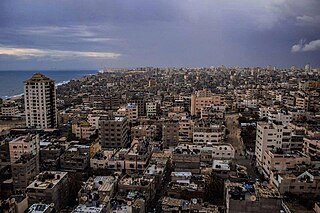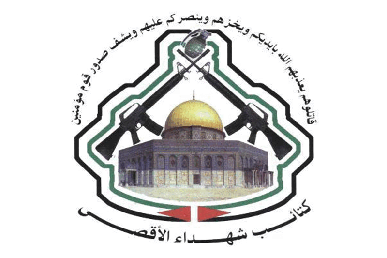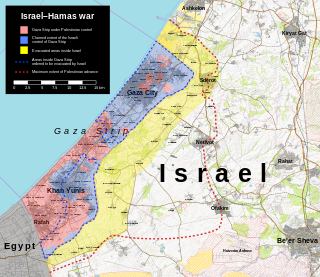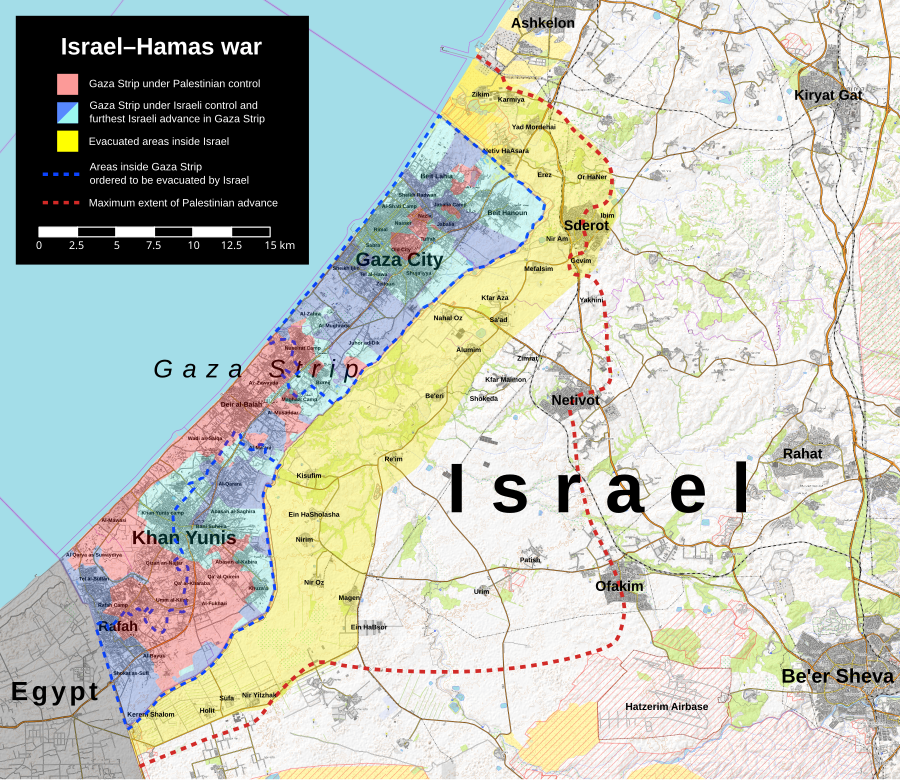
Khan Yunis is a city in the southern Gaza Strip; it is the capital of the Khan Yunis Governorate in the Gaza Strip. According to the Palestinian Central Bureau of Statistics, Khan Yunis had a population of 205,125 in 2017. Khan Yunis, which lies only 4 kilometers east of the Mediterranean Sea, has a semi-arid climate with temperature of 30 degrees Celsius maximum in summer and 10 degrees Celsius minimum in winter, with an annual rainfall of approximately 260 mm (10.2 in).
This page is a partial listing of incidents of violence in the Israeli-Palestinian conflict in 2004.

The Popular Resistance Committees is a coalition of a number of armed Palestinian groups opposed to what they regard as the conciliatory approach of the Palestinian Authority and Fatah towards Israel.

The Izz ad-Din al-Qassam Brigades ;, named after Izz ad-Din al-Qassam, is the military wing of the Palestinian organization Hamas. Currently led by Mohammed Deif and his deputy, Marwan Issa, IQB is the largest and best-equipped militant group operating within Gaza today.

The Gaza War, also known as Operation Cast Lead, also known as the Gaza Massacre, and referred to as the Battle of al-Furqan by Hamas, was a three-week armed conflict between Gaza Strip Palestinian paramilitary groups and the Israel Defense Forces (IDF) that began on 27 December 2008 and ended on 18 January 2009 with a unilateral ceasefire. The conflict resulted in 1,166–1,417 Palestinian and 13 Israeli deaths. Over 46,000 homes were destroyed in Gaza, making more than 100,000 people homeless.

The 2006 Gaza cross-border raid was an armed incursion carried out by seven or eight Gazan Palestinian militants on 25 June 2006 who attacked Israel Defense Forces (IDF) positions near the Kerem Shalom Crossing through an attack tunnel. In the attack, two IDF soldiers and two Palestinian militants were killed, four IDF soldiers were wounded, one of whom was Gilad Shalit, who was captured and taken to the Gaza Strip.

The al-Aqsa Martyrs' Brigades is a coalition of Palestinian armed groups in the West Bank. The organization has been designated as a terrorist organization by Israel, the European Union and various other countries.
The following is a timeline of the 2014 Gaza War. Over 2014, Palestinians suffered the highest number of civilian casualties since the Six-Day War in 1967, according to a United Nations report, given the July–August conflict, and rising tolls in the West Bank and East Jerusalem. A spike in Israeli casualties also occurred. 2,256 Palestinians and 85 Israelis died, while 17,125 Palestinians, and 2,639 Israelis suffered injuries.

A vast network of tunnels used for smuggling and warfare purposes exists under the Gaza Strip. The underground tunnel network allows Hamas and other militant groups to store and shield weapons, gather and move underground, communicate, train, launch offensive attacks, transport hostages, and retreat without being detected by Israeli or Egyptian authorities. This network of tunnels is colloquially referred to as the Gaza metro. According to Tehran IRGC General there are more than 500 kilometers of tunnels.

Yahya Sinwar, also spelled Yehya Sinwar, is a Palestinian politician who has been leader of Hamas, the Sunni Islamist political and military organization that rules the Gaza Strip, since 2017.
Events of the year 2023 in Israel.
Events in 2023 in the Palestinian territories.

On the evening of 27 October 2023, Israel launched a large-scale invasion of the Gaza Strip, as part of the Israel–Hamas war, with the stated goal of destroying Hamas and overthrowing the organization's governance of the Gaza Strip.

The Battle of Beit Hanoun began on 27 October 2023 in the midst of the 2023 Israeli invasion of the Gaza Strip. On 18 December 2023, it was reported that Israeli forces had full control over Beit Hanoun and had destroyed Hamas’ Beit Hanoun Battalion.

The siege of Gaza City began on 2 November 2023, when Israel Defense Forces (IDF) surrounded Gaza City. The siege is part of the ongoing Israeli invasion of the Gaza Strip, which was a counterattack to the 2023 Hamas-led attack on Israel. Gaza City is the most populated city in the Gaza Strip and the battle started on 30 October 2023, when Israel and Hamas clashed in Gaza City. According to Oxfam, there are about 500,000 Palestinians, along with 200 Israelis and other captives, currently trapped in a "siege within a siege" in northern Gaza.
On 13 December 2023, during the wider Israeli invasion of Gaza, Hamas forces carried out an ambush at Shuja'iyya. The ambush resulted in the deaths of 10 Israeli soldiers. One of the dead soldiers was Colonel Yitzhak Ben-Bashat.
Events in 2024 in the Palestinian territories.
Mohammed Sinwar, is a leader of the Izz ad-Din al-Qassam Brigades, the military wing of Hamas, based in the Gaza Strip. His brother is the head of the Hamas government in the Gaza Strip, Yahya Sinwar. He spent several years in Israeli jails in the 1990s and became the leader of Hamas' Khan Younis Brigade in 2005. He has been subject to several assassination attempts by Israel.









